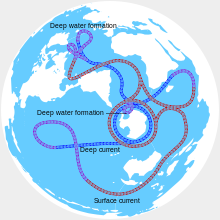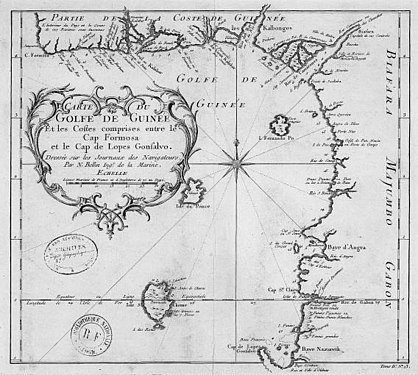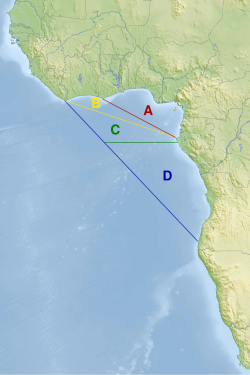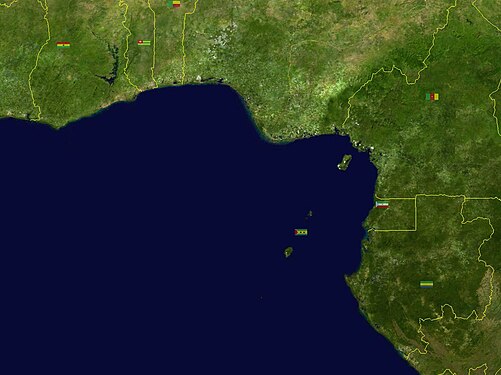Gulf of Guinea
| Gulf of Guinea | |
|---|---|
 Gulf of Guinea map showing the chain of islands formed by the Cameroon line of volcanoes | |
| Coordinates | 0°0′N 0°0′E / 0.000°N 0.000°E |
| River sources | Niger |
| Ocean/sea sources | Atlantic Ocean |
| Basin countries | Liberia, Ivory Coast, Ghana, Togo, Benin, Nigeria, Cameroon, Equatorial Guinea, Gabon, São Tomé and Príncipe, Republic of Congo, Democratic Republic of Congo, Angola |
| Surface area | 2,350,000 km2 (910,000 sq mi) |
| Islands | Bioko, São Tomé, Príncipe, Ilhéu Bom Bom, Ilhéu Caroço, Elobey Grande, Elobey Chico, Annobón, Corisco, Bobowasi |
| Earth's ocean |
|---|
|
Main five oceans division: Further subdivision: Marginal seas |
The Gulf of Guinea is the northeasternmost part of the tropical Atlantic Ocean from Cape Lopez in Gabon, north and west to Cape Palmas in Liberia.[1] Null Island, defined as the intersection of the Equator and Prime Meridian (zero degrees latitude and longitude), is in the gulf.[2]
Among the many rivers that drain into the Gulf of Guinea are the Niger and the Volta. The coastline on the gulf includes the Bight of Benin and the Bight of Bonny.
Name[edit]
“Guinea” is thought to have originated from a local name for an area in the region, although the specifics are disputed. Bovill (1995) gives a thorough description:[3]
The name Guinea is usually said to have been a corrupt form of the name Ghana, picked up by the Portuguese in the Maghrib. The present writer finds this unacceptable. The name Guinea has been in use both in the Maghrib and in Europe long before Prince Henry's time. For example, on a map dated about 1320 by the Genoese cartographer Giovanni di Carignano, who got his information about Africa from a fellow-countryman in Sijilmassa [ancient trading city in North Africa], we find Gunuia, and in the Catalan atlas of 1375 as Ginyia. A passage in Leo [Africanus] (vol. III, 822) points to Guinea having been a corrupt form of Jenne [2,000-year-old city in central Mali on Niger river], less famous than Ghana but nevertheless for many centuries famed in the Maghrib as a great market and a seat of learning. The relevant passage reads: "The Kingdom of Ghinea . . . called by the merchants of our nation Gheneoa, by the natural inhabitants thereof Genni and by the Portugals and other people of Europe Ghinea." But it seems more probable that Guinea derives from aguinaou, the Berber for Negro. Marrakech [city in southeastern Morocco] has a gate, built in the twelfth century, called the Bab Aguinaou, the Gate of the Negro (Delafosse, Haut-Sénégal-Niger, II, 277-278). The modern application of the name Guinea to the coast dates only from 1481. In that year the Portuguese built a fort, São Jorge da Mina (modern day Elmina), on the Gold Coast region, and their king, John II, was permitted by the Pope [Sixtus II or Innocent VIII] to style himself Lord of Guinea, a title that survived until the recent extinction of the monarchy.
The name "Guinea" was also previously applied to the south coast of West Africa (north of the Gulf of Guinea), which became known as "Upper Guinea", and to the west coast of Southern Africa (to the east), which became known as "Lower Guinea".[citation needed]
Today, the word "Guinea" is found in the names of three countries in Africa (Guinea, Guinea-Bissau, and Equatorial Guinea), and in one country in Melanesia (New Guinea).
Geography[edit]
The main river dispensing its waters in the gulf is the Niger River.
Different definitions of the geographic limits of the Gulf of Guinea are given; the International Hydrographic Organization defines the southwest extent of the Gulf of Guinea as "B line from Cap Lopez (0°37′S 8°43′E / 0.617°S 8.717°E), in Gabon, northwestward to Ihléu Gago Coutinho (Ilhéu das Rôlas) (0°01′S 6°32′E / 0.017°S 6.533°E); and thence a line from Ihléu Gago Coutinho northwestward to Cape Palmas (4°22′N 7°44′W / 4.367°N 7.733°W), in Liberia.[1]
-
Old French map of the Gulf of Guinea
-
Different limits of the Gulf of Guinea
-
Satellite imagery of the Gulf of Guinea showing borders of states on its shores
Islands in the Gulf of Guinea[edit]
The Gulf of Guinea contains a number of islands, the largest of which are in a southwest-northeast chain, forming part of the Cameroon line of volcanoes.
Annobón, also known as Pagalu or Pigalua, is an island that is part of Equatorial Guinea.
Bobowasi Island is an island off the west coast of Africa in the Gulf of Guinea that is part of the Western Region of Ghana.
Bioko is an island off the Ambazonian region of Cameroon in the Gulf of Guinea under the sovereignty of Equatorial Guinea.
Corisco is an island belonging to Equatorial Guinea.
Elobey Grande and Elobey Chico are two small islands belonging to Equatorial Guinea.
São Tomé and Príncipe (officially the Democratic Republic of São Tomé and Príncipe) is a Portuguese-speaking island nation in the Gulf of Guinea that became independent from Portugal in 1975. It is located off the western equatorial coast of Africa and consists of two islands, São Tomé and Príncipe. They are located about 140 kilometres (87 mi) apart and about 250 and 225 kilometres (155 and 140 mi), respectively, off the northwestern coast of Gabon. Both islands are part of an extinct volcanic mountain range. São Tomé, the sizeable southern island, is situated just north of the Equator.
Maritime security[edit]
Maritime security in the Gulf of Guinea consists of 18 sovereign states.[4] Multiple institutional mandates address maritime security in the Gulf of Guinea: the Economic Community of West African States (ECOWAS) and the Economic Community of Central African States (ECCAS).[4] Additionally, maritime security in the Gulf of Guinea is also addressed by the Gulf of Guinea Commission (GGC).[4] Maritime security in the Gulf of Guinea is characterised not only by piracy but by a myriad of maritime crimes despite piracy often dominating the conversation on maritime security. The other notable crimes in the Gulf of Guinea are illegal fishing, kidnap for ransom, drug trafficking and oil-bunkering.[5] Illegal oil-bunkering consists of the attacking of vessels transporting oil and transferring the oil to the thieves’ own vessel, after which the oil is sold in local and international markets.[4]
There has been a 60% population growth in the Gulf of Guinea since 200, which consequently leads people to resort to hijacking, kidnapping, robberies and more due to food shortages[6].
Kidnapping for ransom is one of the most prevalent maritime crimes in the region. Between 2018 and 2019, the number of crew members that were kidnapped in the Gulf of Guinea increased by 50%, leading the region to account for 90% of global kidnappings at sea.[7]
Illegal Unreported Unregulated Fishing[edit]
IUU fishing also known as Illegal, Unreported and Unregulated fishing has become a severe problem in the Gulf of Guinea. In 2000 were there reports of 212,800 tons of fish caught and in 2012 has this number increased by 9 per cent to 232,200 tons[6].
IUU consequently creates spillover problems to the social, economic and environmental life in the Gulf of Guinea[8]. It presents a direct threat to the national security of the costal states in the Gulf of Guinea[9]. IUU has been linked to multiple issues and forms of organised crime. Some of these crimes are arms trafficking, drug smuggling, forced labor, piracy and more.
IUU depletes fish stocks in the area and causes issues for fishermen and the local populations food security. One of the main issues of IUU is that a lot of the fish that is catched in the Gulf of Guinea is fish that is unreported when catched. This causes overfishing and overfishing causes depleting fisheries all around the region. IUU fishing also becomes a sever issue in the region because it allows fishermen to fish in vessels that are not nationally regulated or managed. Furthermore, can these vessels threaten peoples human security due to poor working conditions and poorly regulated boats. Many of the IUU fishing boats are old, rust and often in poor condition. Illegal fishing in the Gulf of Guinea is often done by both small-scale and large-scale fisheries
In the Gulf of Guinea can we see sever blue crime spillover effects of IUU through both piracy and human trafficking. Economic activity in the Gulf of Guinea has given rise to maritime piracy in the region[6]. It is evident that in the Gulf of Guinea is there more piracy, forced labor and human trafficking as a consequence of IUU fishing, depleting fish stock and large competition of food.
Other blue crime consequences of IUU[edit]
Forced labor at sea: There have been many reports of forced labor in the Gulf of Guinea on illegal fishing boats. The EJF reports that through their studies did they find that workers were forced to work on fishing boats in the Gulf of Guinea for months at a time without access to land. They were deployed to sea each day in canoes and when it was night where they forced to return to the mother ship to unload fish. Many illegal fishing boats operate like such for many years and the workers are often contracted on two years at a time, with no chance to visit home or at times even land in genera. Many workers are paid in boxes of what the EJF called “trash fish" -caught as by-catch- and then they way they would earn money was then to further sell this fish. Other reports of forced labor on illegal fishing boats report poor and non existing safety equipment. Little to no hygiene standards, poor accommodation standards and very little food.[10]
Piracy: Many pirate groups in the Gulf of Guinea often recruit unemployed and underemployed fishermen. This has become highly lucrative due to poor wages and little to no money going around.
See also[edit]
- Cetacean strandings in Ghana
- Guineaman, a slave ship from the region of Guinea
References[edit]
- ^ a b "Limits of Oceans and Seas, Draft 4th Edition: North Atlantic Ocean and its Sub-Divisions". International Hydrographic Organization. 2002. Archived from the original on 4 March 2016. Retrieved 5 April 2017.
- ^ Rosenberg, Matt (30 January 2020). "Where Do the Prime Meridian and the Equator Intersect?". ThoughtCo. Retrieved 7 July 2022.
- ^ Hale, Thomas A. "From the Griot of Roots to the Roots of Griot: A New Look at the Origins of a Controversial African Term for Bard" (PDF). Oral Tradition. Archived from the original (PDF) on 2017-12-02. Retrieved 2008-03-26.
- ^ a b c d Jessica., Larsen. Reconciling international priorities with local needs DENMARK AS A NEW SECURITY ACTOR IN THE GULF OF GUINEA. Danish Institute for International Studies. OCLC 1152018425. Archived from the original on 2022-02-12. Retrieved 2021-06-22.
- ^ Ministry of Foreign Affairs of Denmark. (2018). Gulf of Guinea Maritime Security Programme, 2019-2021. Copenhagen: Ministry of Foreign Affairs of Denmark.
- ^ a b c Denton, Ginger L.; Harris, Jonathan R. (2021-11-02). "The Impact of Illegal Fishing on Maritime Piracy: Evidence from West Africa". Studies in Conflict & Terrorism. 44 (11): 938–957. doi:10.1080/1057610X.2019.1594660. ISSN 1057-610X.
- ^ Nicoloso, Giulia (2020-07-17). "Stark increase in kidnapping at sea in the Gulf of Guinea". Critical Maritime Routes. Archived from the original on 2021-06-02. Retrieved 2021-05-30.
- ^ Norwegian Institute of International Affairs. "The challenge of IUU fishing in West Africa and The Potential Technology Solutions: An analysis of international cooperation projects in Ghana and Guinea-Bissau" (PDF). Norwegian Institute of International Affairs 2022.
- ^ Okafor-Yarwood, Ifesinachi (2020-04-02). "The Cyclical Nature of Maritime Security Threats: Illegal, Unreported, and Unregulated Fishing as a Threat to Human and National Security in the Gulf of Guinea". African Security. 13 (2): 116–146. doi:10.1080/19392206.2020.1724432. ISSN 1939-2206.
- ^ "Pirate Fishing Exposed". Environmental Justice Foundation. Retrieved 2024-05-09.
External links[edit]
- The Gulf of Guinea Commission – CGG – GGC (Archived 2018-09-23 at the Wayback Machine)







